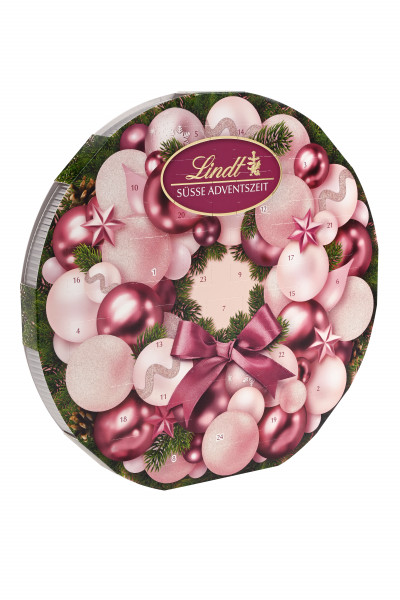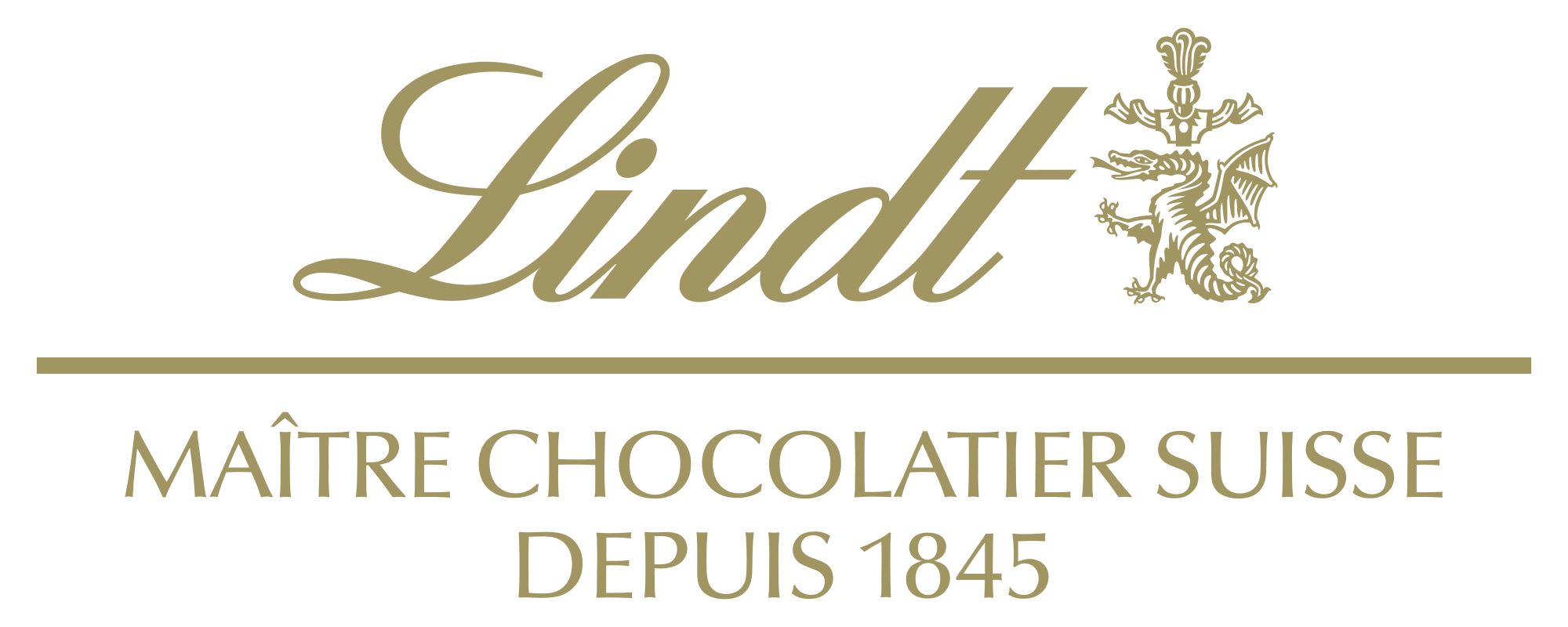| Quantity | Unit price | Reference price |
|---|---|---|
| To 1 | €19.95 * | €73.89 * / 1 kg |
| From 2 | €18.95 * | €70.19 * / 1 kg |
*prices incl. VAT plus shipping costs
unfortunately currently sold out
- Order number: 461099
- best before:
- Allergen-Information: May contain ALMOND and other SHELL FRUITS.
- EAN: 4000539743580
- Manufacturer product ID: 74359
- advice: Store in a cool (<25°) and dry place.
Advent calendar with decorative Advent wreath motif
The Maîtres Chocolatiers of Lindt have stood for the art of confectionery for over 165 years. The fine melting of all Lindt chocolate specialties is incomparably delicate, dating back to the invention of the conche by Rodolphe Lindt in 1879 and the reason for the worldwide fame of Lindt & Sprüngli to this day.
From December on, the anticipation of Christmas starts. Whether for young or old: Advent calendars are indispensable here, because they sweeten the wait for Christmas day after day. Surprises made from the finest LINDT chocolate are waiting behind all the doors.
Day after day, all 24 doors increase the anticipation of connoisseurs young and old with the finest chocolate treats. Including practical stand-up function - ideal for desk, shelf, windowsill or sideboard.
The following pralines await you in this Advent calendar:

- 2x balls of nougat
- 3x Lindor balls milk
- 3x Lindor balls white
- 2x balls Christmas nut cream with cinnamon and coriander
- 2x balls Dark Cacao Nibs
- 2x CRESTA
- 2x scoops Crème Brûlée
- 4x mini nut cream ball
- 4x Mini double milk scoop
- 4x Mini Alpine milk scoop
- 1x Mini Christmas Angel Milk
- 1x Santa Claus milk
| Filling quantity (weight): | 270g |
| Sweets for adults and kids: | advent Calendar, chocolate, Pralinés, seasonal items |
| Gifts: | Yes |
| country of origin: | EU / non-EU Agriculture |
| Shipping weight: | 1,04 kg |
| Manufacturer: | Lindt & Sprüngli |
| Dimensions HxWxD (approx.): | 370x370x35 mm |
| product group: | advent Calendar, chocolate |
| brand: | Lindt |
| further properties: | non-alcoholic |
| Manufacturer address: | Chocoladefabriken Lindt & Sprüngli GmbH. Süsterfeldstr. 130. D-52072 Aachen |
Manufacturer Contact: Chocoladefabriken Lindt & Sprüngli GmbH, Süsterfeldstr. 130, 52072 Aachen, Deutschland
Chocoladefabriken Lindt & Sprüngli Aktiengesellschaft is an international Swiss chocolate manufacturer based in Kilchberg (ZH) in Switzerland. The origins of Lindt & Sprüngli lie in the two chocolate factories of Rudolf Sprüngli in Horgen and Rodolphe Lindt in Bern. Rudolf Sprüngli Junior took over his father's company in 1891. A year later, Confiserie Sprüngli was hived off as a separate company. In 1899 Rudolf Sprüngli built the factory in Kilchberg and in the same year converted the company into a stock corporation. Soon after, Chocolat Sprüngli AG took over the Bernese chocolate factory of Rodolphe Lindt, together with the patent for its conching process. The joint stock company Vereinigte Berner and Zurich Chocoladefabriken Lindt & Sprüngli was born. Lindt & Sprüngli produces chocolates in addition to a variety of different chocolate bars. There are also seasonal products such as Santa Claus or Easter items. Increasingly important are chocolate bars with high cocoa content (> 60 percent) or exotic ingredients such as pepper or crushed chili peppers.
The history of Lindt
The small brown beans of the cocoa tree Theobroma cacao are among the most fascinating treasures ever discovered. The "food of the gods," as it is called in Greek, conquered the world and cast a spell over all, whether kings or ordinary citizens, physicians, scientists, or church representatives.
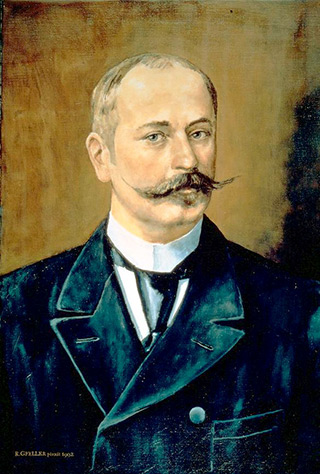 Rodolphe Lindt
Rodolphe LindtSo also Rodolphe Lindt, the 24-year-old master confectioner and son of a pharmacist. In 1879, near Berne, he bought two factories destroyed by fire and some outdated machines. He wanted to make chocolate, as they did not exist before. At that time, chocolate was a friable substance with a rough surface pressed by hand.
His brother August, also a pharmacist, was of the opinion that the moisture of the chocolate mass crystallized with the sugar would have to be extracted during processing. And why not add cocoa butter to soften the traditional consistency of the chocolate mass?
The substance that came into being when Rodolphe Lindt stirred three days and nights continuously differed greatly from the traditional chocolate mass. The dark, velvety mass had a dull glow, was easy to shape and completely melted on the tongue. This novel chocolate was able to develop all its aroma. She was unique and far better than her predecessors. Lindt called her "Chocolat Fondant", literally "melting chocolate".
Thus, in 1879, the world's first chocolate with delicate, fine enamel was created. Was this discovery a coincidence? Did the experimental phase last longer than the legend says? Or was it, as it wants another version of the company's history, that Lindt forgot to turn off the mixer on the weekend in question? Of course, we can not confirm all the details of the events that took place more than 130 years ago.
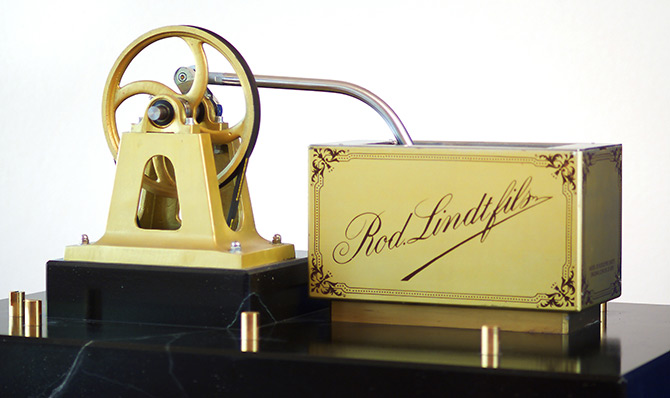
However, it is undisputed that conching, Lindt's revolutionary discovery, contributed significantly to the international reputation of Swiss and LINDT chocolate.
Why is LINDT chocolate so special? Delicious chocolate does not just stem from the long hours of conching - the exclusive LINDT chocolates also need true pioneering spirit, passion, care, skill and expertise.
The history of cocoa
Cacoa, the name of the seeds of cocoa, the cacao beans, but goes much further back to the Olmec, one of the earliest Central American high cultures, which were located about 3000 years ago in Mexico. The humid, warm climate was ideal for the flourishing of the delicate cocoa tree.
The Mayans, who settled several centuries after the demise of the Olmecs in southern Mexico, invented a bitter and strong flavored drink that was made from cocoa beans and was sacrificed on the occasion of holy rituals by priests, kings and nobles and drank. But also the civilization of the Mayas took an enigmatic ending to this day and it was around the year 900 AD. the Toltec and then the Aztecs. These took over the tradition of the holy drink, which they called "Xocoatl" (xoco = herb, atl = water). For the Aztecs, the bitter-spicy potion was a source of wisdom and energy, an aphrodisiac and soothing balm. The valuable cocoa served at this time as a means of payment and was also presented to the gods as an offering.
The first European to come into contact with cocoa was Christopher Columbus. In 1502, on his fourth voyage, he tasted the bitter drink - and found it not at all to his liking: too bitter, too spicy. Only years later, in 1528, did the Spanish conquistador Hernado Cortez bring the brown gold and the recipe for the exotic potion to Spain. Sugar and other ingredients were added to the energizing, novel drink that the Spaniards called "chocolate," and it soon became a fashionable delicacy that was enthusiastically consumed at the Spanish court for about a century. Not until 1615, when the Spanish princess Anna was married to the French King Louis XIII, The exclusive drink came to France and spread from there over all royal courts in the finest social groups in Europe. And until the onset of the Industrial Revolution, the enjoyment of chocolate - then still in the form of hot drinking chocolate - was reserved for the well-to-do.
Then came the time of the chocolate pioneers who, in Italy, Belgium, Germany, Holland and of course also in Switzerland and other countries, put their ambitious visions, their genius and their skills to use different techniques and recipes from the popular drink to make solid chocolate, which should gradually be accessible to all citizens. So many have contributed to significantly enrich the modern chocolate history and shape, but the most groundbreaking of all innovations was probably the Chonchierverfahren, the Swiss Rodolphe Lindt invented in 1879 and thanks to which the then brittle-sandy and slightly bitter mass in the mouth Melting came, and the chocolate enjoyment made it really perfect.
The production of Lindt chocolate
Processing cocoa beans into fine chocolate requires expertise, passion and craftsmanship. This begins in the tropical rainforest and ends at the LINDT Chocolate Factory, where passionate maîtres chocolatiers lovingly draw attention to creations such as shiny dark chocolate bars, mild-melting milk chocolate or praline masterpieces and other delicacies.
The process of chocolate production takes place in three stages:
Stage 1: Culture and harvest
Farmers are first cultivating cocoa beans: LINDT uses mostly high-quality fine cocoa - Criollo and Trinitario - from selected regions in South and Central America and West Africa.
These precious cocoa beans account for less than 5% of the world's harvest, and are therefore more expensive not only for their wonderful aroma, but also because farmers who cultivate cocoa, which is important for LINDT's quality aspirations, receive a higher income in the interests of fair trade. The consumer cocoa also used by LINDT comes mainly from Ghana, where one of the best forasteros grows.
Cocoa is harvested by hand, fermented and dried. This is a labor-intensive process that takes place locally.
When cocoa trees reach maturity, they produce white or pink five-petalled flowers throughout the year, as well as fruits, the cocoa pods that attach directly to the stem. This phenomenon, called Stammblütigkeit, distinguishes the cacao tree mostly from plants whose flowers and fruits sit on the tips of the outermost branches.
A skilled and brisk worker can open about 500 pods an hour! There are no harvesters for cocoa - farmers use short blades mounted on long poles to reach the highest fruit. The pods of the pods are opened with machetes to peel out the cocoa beans surrounded by pulp.
In the next step, the beans are stored in large boxes, or piled up and covered with banana leaves. During the next 3-7 days, the beans are fermented. The flesh heats up around the beans, activates enzymes and creates compounds that give the beans their chocolate flavor - losing about 50% of their weight. The fermentation is complete when the beans have become deep dark brown.
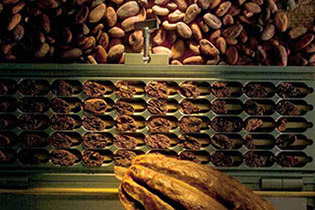
Stage 2: selection and review of the beans
After harvesting and fermentation, the cocoa beans are shipped to their countries of destination where they are further processed.
Before the cocoa varieties selected by Lindt & Sprüngli are finally processed into noble LINDT chocolate, they must undergo critical quality controls. Numerous in-house laboratory tests are used to check that the goods are in perfect condition and have survived the long journey undamaged.
Stage 3: Processing the chocolate
Upon arrival, the cocoa beans are cleaned and separated from their shells. These so-called cocoa nibs are carefully roasted at LINDT according to in-house procedures. This process is also important for the formation of the first delicate flavors. Then they are broken in special mills and finely ground until liquid cocoa mass is produced. It is the most important ingredient - the basis - for the production of chocolate. After that, the chocolate production can begin by mixing the other three basic ingredients (cocoa butter, sugar, milk) with the cocoa mass.
Thereafter, the mixture is refined by steel rollers which reduce the small cocoa and sugar particles into microscopic particles. The subsequent conching takes several hours depending on the recipe. In the conche, the chocolate is kneaded and stirred, and cocoa butter and lecithin (a soy-based emulsifier) are added. The conching was invented in 1879 by Rodolphe Lindt. That was a revolutionary process for the chocolate world. With the addition of cocoa butter, cocoa mass is stirred for hours in an elongated conche, so that the chocolate is "ventilated" and the bitter-sour aromas gradually escape.
The constant stirring also has a homogenizing effect: This forms a very thin layer of cocoa butter around each of the smallest particles. The result is velvety soft chocolate with a harmonious taste. For a perfect look, the chocolate must be tempered, ie heated, cooled and reheated. By tempering the chocolate gets a velvety gloss, a matte shimmer and good breaking strength. Finally, the chocolate is formed into sheets or poured into other products and packaged for retail.
Lindt Pralinés
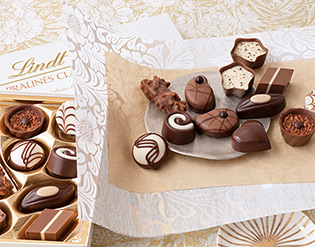
Pralinés are the highest creation in the kitchen of the Maîtres Chocolatiers. When the desirable delicacies emerge, there is a lot of manual skill in the game that expresses love and passion. Thus, the small masterpieces have a magical attraction, which entices the connoisseur again and again.
A truly delicious story
The 17th century is considered the year of birth of pralines. According to legend, the first dessert that combined almonds with liquid sugar was created at the court of the French Sun King Louis XIV. This delicacy was created by the chef of the French Field Marshal Comte du Plessis Praslin.
This decided to call the invention in honor of Field Marshal "Praslines". This eponymous delicacy was used by the field marshal to graciously congratulate the ladies of the royal court and diplomatic envoys.
However, it took some time before the noble chocolate pralinés their present form was awarded. It was not until 1879, when Rodolphe Lindt decisively improved the chocolate production with the conching process, that it was possible to produce the delicate brilliance of today's pralinés.
Like a good menu, a mixture of pralines lives from the variety and the variety as well as the pleasure of tasting. With the help of the imagination and ingenuity of Maîtres Chocolatiers, new chocolate artworks with interesting recipes, shapes and imaginative decors are created at any time. Demanding connoisseurs thank them and in their leisure hours they always like to open a box of Lindt Pralinés to be surprised by them.
Classic
The mixture "Pralinés Hochfein" is one of Lindt's traditional offerings and offers an exceptional variety of popular specialties such as Gianduja, Marc de Champagne and Nuts-Krokant. Slightly lighter and smaller are the "mini pralines": the smaller, the more often.
sustainability
Cocoa is the most important base for premium chocolate and in its wonderful variety the passion of the maîtres chocolatiers. However, best quality is only created where man and nature interact harmoniously. Therefore, Lindt invests in preserving the environment and improving the living standards of cocoa farmers - only in this way can responsibility for the future be taken over.
We are committed by conviction in the following areas in the sense of a sustainable orientation of all our actions:
|
engagement |
pioneer projects |
cocoa sourcing |
|
Clean drinking water |
Training for children |
New school |
 |  | ||||||||||||||||||||||||
Nutritional information | Ingredients | ||||||||||||||||||||||||
|
| Sugar, cocoa butter, whole MILK powder, cocoa mass, vegetable fat (coconut, palm, palm kernel), hazelnuts, pure butterfat, MILK sugar, skimmed MILK powder, dextrose, low-fat cocoa powder, emulsifier (soya lecithin), cocoa nibs, barley malt extract, glucose syrup, flavors, WHEAT flour, salt, glazing agent (gum arabic), cinnamon, coriander, caramel sugar syrup. Storage informationStore away from heat and dry. | ||||||||||||||||||||||||
The most important ingredient of chocolate: cocoa
The cacao tree (Theobroma Cacao L.) belongs to the subfamily of Byttnerioideae the family of Malvaceae (Mallow family) [earlier classification was Sterculiaceae (Sterculaceae family)]. The Byttnerioideae subfamily is divided into several genera, including the genus Theobroma. This can be divided into 22 species. One species serves us for the production of cocoa: Theobroma cacao L.. The "L." stands for Carl von Linné, the famous Swedish scientist who made a comprehensive classification of plants and gave his name to the cacao tree.
Through breeding, different varieties of Theobroma Cacao L. were created. The most important varieties for cocoa production are Criollo, Forastero and Trinitario.
The cacao tree
The cacao tree is a long, thin understory tree that grows in the shade of larger tropical trees. It can grow 10 to 15 meters tall, but is pruned to 2 to 4 meters on plantations. The tree's taproots penetrate about one meter deep into the ground. The tree has large, smooth, sword-like leaves that are green all year. The cacao tree sprouts new leaves about three to four times a year. Directly on the trunk, which is only about 20 cm thick, and on the larger branches sit the flowers, this is called cauliflory (from the Latin caulifloren = stem flower).

The flower
The flowers arise from the older wood and bloom throughout the year and also produce fruit throughout the year. The cacao tree does not produce flowers until it is 2 to 3 years old. It reaches the greatest number of flowers at the age of ten to twelve years, then the number of flowers can be up to 100,000 per year. The flowers consist of 5 small, narrow, rose-red sepals and 5 petals of yellowish-white or reddish color. The flowers are pollinated exclusively by insects such as mosquitoes that live in the warm, moist undergrowth. On plantations, the flower is sometimes also artificially pollinated.
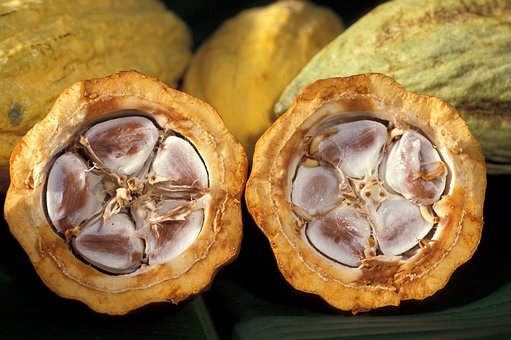
The fruit
The unripe fruit is green in color, while the ripe fruit is yellow, yellow-red or reddish to reddish-brown in color, depending on the variety of cacao. The cucumber-shaped, 15 cm to 25 cm long and 7 cm to 10 cm thick leathery-woody fruits contain 25 to 50 bean-shaped seeds (cocoa beans) in five rows, embedded in a pale sweetish pulp. The seeds are about 2 cm long and 1 cm wide. The fruit sits directly on the trunk. Each tree bears about 20 to 30 fruits per year, and up to 50 fruits in good years.



 Niederegger Advent calendar "Father Christmas", 500g
Niederegger Advent calendar "Father Christmas", 500g 










